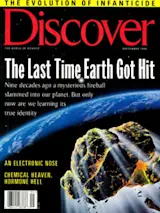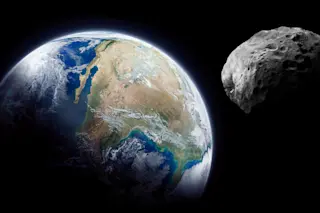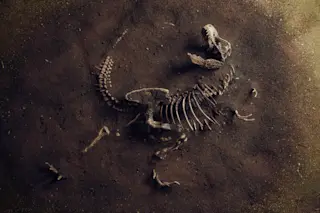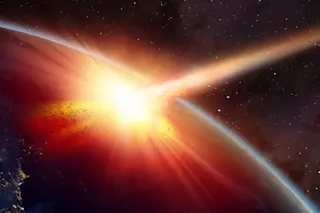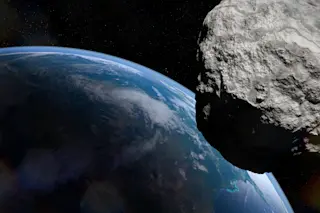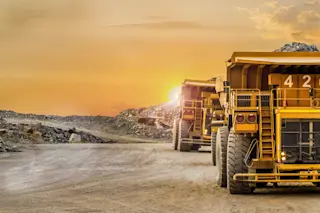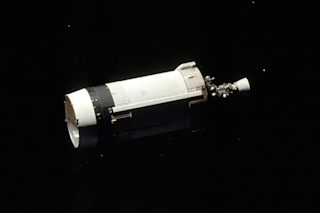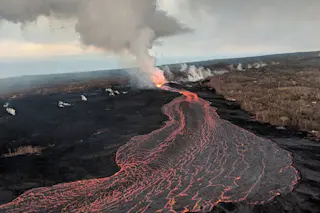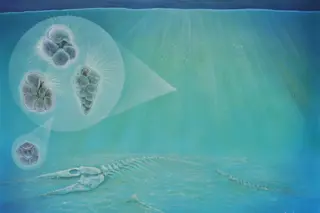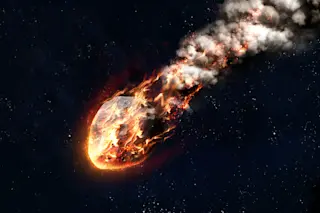On June 30, 1908, a vast fireball raced through the dawn sky over Siberia, then exploded with the force of 1,000 Hiroshima bombs. The heat incinerated herds of reindeer and charred tens of thousands of evergreens across hundreds of square miles. For days, and for thousands of miles around, the sky remained bright with an eerie orange glow--as far away as western Europe people were able to read newspapers at night without a lamp. The effect was much like that of a great volcanic eruption, yet there had been no eruption. The only objective indication of the extraordinary event was a quiver on seismographs in the Siberian city of Irkutsk, indicating a moderate quake some 1,000 miles north in a remote region called Tunguska.
Scientists did not come to Tunguska for another 19 years, apparently reluctant to travel to a site so swampy and remote. When they did finally come, they were rewarded with a stunning vision of utter devastation, with scorched trees lying in rows that stretched to the horizon. They searched for a crater but found none. They searched for fragments of a meteorite--an asteroid or a chunk of one--but found none. All they found were eyewitnesses in neighboring villages who told of a fireball streaking through the sky, horrifying noise, and a blast that knocked people off their feet. Clearly something unprecedented had occurred at Tunguska, but the trees were the only tangible proof that remained.
For 88 years the mystery of Tunguska has attracted a swarm of theories, some eminently reasonable (meteorite impact) and some considerably less so (think exploding spaceship). While the debate continues as to precisely what happened there back in 1908, compelling evidence has recently turned up that could finally put an end to most questions. Researchers have found embedded in Tunguska trees tiny particles with an extraterrestrial signature. Combined with computer simulations, the evidence points to a meteorite born of an asteroid that fragmented in the atmosphere. For many researchers, the debate is no longer whether the cause was a meteorite but exactly what kind of meteorite.
Tunguska is the kind of mystery scientists will try to solve just for the thrill of the challenge, working after hours at laboratories and paying for the travel and fieldwork out of their own pockets. Yet there’s a very practical aspect to the work. Impacts of comets or asteroids-- collectively known as bolides--are an important part of the history of the solar system. Witness, for example, the black eye that comet Shoemaker-Levy gave Jupiter in 1994. Bolides have peppered Earth as well in the past--a particularly big one probably finished off the dinosaurs 65 million years ago--and today they pose an unknown risk to human civilization. Reconstructing that fiery day over Tunguska in 1908 may give us the best picture we have of what future the sky holds for us.
The first scientist to make the journey to Tunguska was Leonid Kulik, a Russian geologist who for years had collected meteorite fragments in other parts of Siberia. When, in 1927, Kulik first saw the vast panorama of charred, downed trees, his immediate impression was that an immense fire had begun simultaneously over a wide area.
Over the next 14 years, Kulik led four more Tunguska expeditions. His teams photographed the flattened trees and dragged the swamps and bogs for meteorite fragments but found nothing. From the dozens of eyewitnesses they interviewed, they collected contradictory accounts: almost half the witnesses claimed seeing a fireball traveling on a northerly path, while the others claimed the path was northwesterly or westerly. Still, despite this paltry, confusing evidence, Kulik was certain that a meteorite had caused the inferno.
Kulik died in 1942 as a prisoner of war. Not until the late fifties would scientists visit Tunguska again. The prod would be Alexander Kazantsev, a Soviet engineer and an army colonel who in 1946 wrote a short story in which he suggested that only a nuclear explosion could have caused the bizarre wreckage at Tunguska. And since humans obviously couldn’t have managed such an explosion in 1908, it must have been caused by an exploding spaceship. Over the years the story was reprinted several times in the Soviet Union, most successfully in 1958 in a popular book called Guest From Space. Young Siberian scientists were intrigued by the notion and by Kazantsev’s claim that there should still be measurable levels of radioactivity at Tunguska. We wanted to find out whether the book was true, says Victor Zhuravlyov, a specialist in ionizing radiation in Tomsk, Siberia. And if it wasn’t, the researchers thought, they could find out what really happened. We thought that in a year or two the Tunguska problem would be solved, says Gennady Plekhanov, former director of the Scientific Research Institute of Biology and Biophysics in Tomsk.
They were wrong. Plekhanov led two expeditions to Tunguska, in 1959 and 1960, looking for evidence of elevated radiation levels and scouring the site for bolide fragments; he found neither. We realized the situation was far more complicated than we had thought, he says. In the spring of 1961, Plekhanov delivered a report on the frustrating field seasons to a packed audience at the Kurchatov Institute of Atomic Energy in Moscow, one of Russia’s top scientific institutes. Despite drawing a blank on the mystery, his group’s careful fieldwork got a warm reception from the scientists.
Since then Russian scientists have gone to Tunguska every summer and have collected a huge amount of data. One of the most important fruits of their ongoing work is a detailed map of the pattern of fallen trees. The scientist in charge of this effort is Wilhelm Fast, a 60-year-old Tomsk State University mathematician who joined the Tunguska group in 1960. The first time I saw the fallen trees, I was in awe, he recalls. Since then he and his co-workers have doggedly mapped the entire 850-square-mile region of tree fall. It is this map, so painstakingly put together over 35 years, that has allowed other scientists to calculate that the trees must have been knocked down by a blast about four miles above the ground with an energy of 10 to 20 megatons of tnt as the object traveled an east-to-west course.
For three decades Tunguska remained an exclusively Russian scientific investigation, chiefly because the two nearest cities, Tomsk and Krasnoyarsk, were centers for research into military technology and were closed to foreigners. But in 1989, with the end of the cold war, outside researchers were at last able to begin studying the site. Among them was the Italian physicist Menotti Galli of the University of Bologna. For 40 years, Galli has studied phenomena associated with cosmic radiation, including the possibility that high-energy particles from space can add heavy isotopes of carbon to the cellulose in trees. And it is in trees, he realized, and particularly in their annual growth rings, that an answer to the Tunguska mystery might be hiding.
Galli got his hands on a chunk of Tunguska spruce taken during the 1990 expedition, a cross-sectional cut a foot in diameter and two inches thick. The wood was hardly museum quality--a dead branch had been enveloped by the growing trunk decades ago, like a splinter beneath the skin, spoiling the concentric pattern of annual rings. But Galli realized that this might make the wood even more useful to him. The branch had died before the 1908 explosion, and the tree had subsequently exuded resin around it in order to protect its living tissue from infection. If a Tunguska bolide had showered any particles onto the forest, they would have been trapped in the resin and might still be intact.
Galli had several candidates in mind for a bolide. It might have been a fragment of a comet, which is essentially a dirty ball of ice, born in the earliest stages of the formation of the solar system and wandering from time to time from its home beyond Pluto to the neighborhood of Earth. On the other hand, it might be one of a number of kinds of meteorites. Meteorites are mostly the battered flotsam of asteroids, which themselves are the wreckage of failed planets. Most are a primordial jumble of minerals and are known as stony meteorites (some of these are rich in organic carbon and are called carbonaceous chondrites). Other meteorites are rich in iron. Each kind of meteorite has a distinctive source: carbonaceous chondrites come from small asteroids on the cool, outward side of the asteroid belt. Closer to the sun, temperatures are too high for the carbon compounds to condense into the asteroids. At this closer range, there are many large asteroids with iron cores. When they disintegrate, the rubble from their exterior becomes stony meteorites, and the core creates iron meteorites.
Galli’s work intrigued his friend and colleague Giuseppe Longo. A nuclear physicist who had spent most of his 36-year career developing arcane formulas to describe how subatomic particles interact in nuclear reactors, Longo saw in Tunguska a respite from the computational grind. With Galli, he decided to test a hypothesis that had been formulated by American scientists in the 1970s but never followed up on: if the Tunguska event had been the explosion of a comet, the hypothesis went, the signature of that comet might still be recognizable. The hydrogen contained within the comet would have been compressed and heated as it hurtled through the atmosphere. Some of it might have fused into helium, triggering an H-bomb- like explosion. Just a few milligrams of fused hydrogen would produce trillions of high-energy neutrons, and these could in turn combine with nitrogen atoms in the atmosphere. Their combination would create a heavy form of carbon, with 14 neutrons rather than the normal 12. If there were processes of this kind, you would find the carbon 14 in the tree rings, Longo says.
No carbon 14 turned up, though. That didn’t necessarily eliminate a comet from the list of bolide suspects, of course, but it did make a comet culprit seem less likely.
Meanwhile, Galli and Longo still had the resin to investigate. As it turned out, they could not accurately date the resin from their single spruce sample, but in the summer of 1991 they were able to join the expedition to Tunguska to gather more samples personally. The researchers flew by plane to the Siberian town of Vanavara, and from there a helicopter brought them to the isolated camp that Kulik had set up 64 years before. Their only link with the outside world was a disassembled radio that the team leader would put back together only for emergency calls to the army outpost at Vanavara. The Italians, accustomed to sipping espressos under Bologna’s endless porticoes, found themselves slaking their thirst with brown swamp water laced with mosquito larvae. Those were ten difficult days, says Galli.
Most difficult of all was finding the right trees for their research. Dozens of larches and pines had survived the blast, but these species produce little resin. The resin-rich trees played hard to get. Often we’d walk 8 or 10 kilometers before finding one surviving spruce, Longo says. Making matters more confusing, the young spruces grew quickly in the open landscape created by the cataclysm, so they weren’t much smaller than the ones that were alive in 1908. Nine out of ten spruces the researchers cored turned out to have been born after the event.
In all, the Italians found six spruces within a five-mile radius that had survived the blast. They gouged out 13 core samples the size of healthy carrots and were sure each time to extract the wood and resin around dead branches. For comparison, they sampled other trees near the epicenter, including the roots of a larch that had been overturned in the blast, as well as a spruce in Tomsk, 700 miles southwest of the epicenter.
Back in Bologna, they worked with physicist Romano Serra to analyze the material. They extracted from the resin particles measuring less than a thousandth of an inch across and studied them under a scanning electron microscope. Attached to the microscope was a device known as an energy dispersive X-ray spectrometer, which Serra used to get a rough idea of the composition of the particles. The spectrometer fires an X-ray beam with a width less than a quarter that of the particles. Electrons in atoms on the particles’ surfaces absorb the energy and then a fraction of a second later release it, emitting patterns of energy unique to particular elements.
Over the next two years the researchers gathered data on 5,854 particles from resin exuded by the six spruces and the pines near the epicenter, as well as 1,138 particles in the larch roots and the Tomsk spruces. Because the resin can’t be assigned precisely to adjacent tree rings, the particles couldn’t be dated more precisely than to say they belong to one of three periods--1885 to 1901, 1902 to 1914, or 1915 to 1930. Nevertheless, within those constraints, the results were striking: in the period from 1902 to 1914, a significant number of particles had unusually high levels of elements like copper, gold, and nickel. Because many of these elements have a relatively high number of protons (denoted by physicists as Z), the researchers dubbed the particles that contain them high-Z particles. There were 10 times more high-Z particles in the period of the fireball than before or after, which made the Italians wonder if these particles had an extra-Earthly origin.
The great and important question was how these particles are related to the Tunguska event, Longo says. It was possible, for example, that a bolide had indeed exploded but that these particles had simply been kicked up from the soil by the impact. To answer this question, the scientists compared the particles found in the living Tunguska trees with those in the larch roots. Because the blast wave uprooted the larch, the resin around its roots would have captured particles thrown up from the ground. Their hunch proved correct: the particles in the root resin contained combinations of elements that were fundamentally different from those in the tree resin.
Another hint that the particles from the spruce trees were from a bolide was their smooth texture and spherical shape. To get these particles in such a form, you have to heat them to very high temperatures. The blast wave would not have melted particles in the ground, where the conductivity is too low, says Longo. That means the melted particles came directly from the cosmic body.
But exactly what kind of body produced them? On this question, Longo and his Bologna colleagues are quiet. The absence of a fusion explosion might argue against comets, but a conventional explosion of a comet can’t be ruled out. Years ago, Longo explains, astrophysicists assumed that comets were composed only of light elements like hydrogen and helium. Now they think that some comets have cores containing heavy elements.
The particles could also have come from any of a number of kinds of meteors, since they are such complex jumbles of elements. With an asteroid you can find what you want to find, Longo says. What they do show, the Italians maintain, is that a bolide from space left its mark at Tunguska.
While the Italians have been sorting through particles, American researchers have been creating computer simulations of Tunguska, trying to use the laws of physics to re-create a bolide that could have produced the known evidence. The first simulation to draw major attention in the West was performed three years ago by planetary scientist Chris Chyba of Princeton and Paul Thomas and Kevin Zahnle of the nasa Ames Research Center in California. Chyba and Thomas had developed formulas to describe a comet as it flies through an atmosphere; Zahnle meanwhile had studied what happens when a bolide hits the ground or disintegrates in midair.
They combined their expertise to simulate what had happened at Tunguska. Small bolides burn up quickly in our atmosphere, while huge ones reach the ground. But when a midsize bolide (between 10 and 300 feet wide) falls, the researchers found, something different happens. As the bolide rips through the atmosphere, the air exerts intense pressure on its front end. The rock begins to deform, and it spreads out like pancake batter. However, there’s practically no pressure being applied to the back of the bolide. As a result of the huge difference in the forces acting on different areas of the object, it is torn into pieces. The fragments themselves are subjected to the same series of forces, and they are blasted apart as well. In a few tenths of a second, the feedback loop of braking and fragmentation turns a bolide into a cloud of debris, looking as if it had been dynamited in midair.
Chyba and Zahnle decided to see if this chain of events could explain what happened in Siberia. We set out to find as simple a model for Tunguska as we could, Chyba says. The more variables that can be assigned hard numbers, the better a model works, but the Ames group had few at their disposal. They didn’t know how big the bolide was; whether it contained ice, stone, iron, or other materials; how fast it was going; or even its angle of trajectory--eyewitness accounts suggested 5 to 17 degrees, while tree-fall patterns pointed to a steeper incline of between 30 and 40 degrees.
Faced with these uncertainties, the Ames group tried out a range of possibilities. They found that iron meteorites were too strong and dense; they simply slammed into the surface of Earth unless the researchers dropped them at 25 miles a second--a speed rarely achieved in nature. Comets, on the other hand, were so delicate that they exploded 14 miles or higher in the air, too high to match the Russian calculations from the tree-fall patterns. Carbon-rich carbonaceous chondrites entering the atmosphere at 45 degrees, they calculated, blew apart at 9 miles, which was some 5 miles too high.
But other, heavier stony meteorites met the Goldilocks requirements: a 200-foot-wide stony meteorite falling to Earth at a 45- degree angle would explode at exactly the right height over Tunguska. Moreover, such an event could also explain the light nights in Europe and Asia that followed the explosion: the force of the blast wave from the Tunguska body, the model suggests, lofted dust into the upper atmosphere high enough to reflect light from the sun long after it had set.
Other simulators have found that meteorites can fit the Tunguska glove. Jack Hills of Los Alamos National Laboratory and Patrick Goda, now a graduate student at the University of Hawaii, did their own calculations for Tunguska, and their results suggest the same culprit as Chyba’s group. But they pursued the scenario further and calculated exactly what happened to the fragmented meteorite. They found that while most of it would have burned up during disintegration, 10 percent would have survived and sprinkled down onto a mere square mile or so of forest as fine gravel. It is clear why no large meteorites have been found from this fall, Hills says.
The pattern of actual Tunguska particles may be consistent with such a scenario. Two trees that Longo’s group sampled about half a mile south of the epicenter at Tunguska contained far higher concentrations of particles than did trees farther away from the blast. Between the epicenter and the particle-spattered trees is a wide boggy area called the Southern Swamp. If a lot of the debris fell into the Southern Swamp, it would be extremely difficult to find fragments 20 years after the explosion, says Longo.
But the most recent American simulation has made matters a bit fuzzier. Evans Lyne and Richard Fought of the University of Tennessee at Knoxville and Michael Tauber of Stanford realized that the previous studies by Chyba and Hills had assumed that as a bolide fell, it would heat the air in front of it to some 45,000 degrees, and that most of this tremendous heat would get trasnsferred to the bolide and burn it away. This in turn would determine how much of the bolide would be left when it exploded and how high above the ground that explosion would occur. What these studies hadn’t considered, Lyne and Fought found, was that as the layer of air directly in front of the falling bolide heats up, the gas begins to glow and to radiate heat away. Consequently, the gas can’t get as hot as had been assumed. That means that less heat is transferred to the bolide, less of the object is burned up, and so it can get closer to Earth before the pressure gradient tears it apart. By this reasoning, carbonaceous chondrites, which Chyba had ruled out, explode at the right height to account for the effects seen at Tunguska. However, Lyne also notes that his simulations create a lot of wiggle room--even a comet could have exploded low enough if it had come in at a sufficiently steep angle. I don’t feel strongly that any particular type of body can be pinned down, he says.
Many of the Russian researchers who have been wrestling with Tunguska for years view the American efforts with skepticism. Most still cling to the idea, popular in the 1970s, that the Tunguska bolide was not part of an asteroid but a comet. The hypothesis rests in part on the eyewitness accounts of the bolide’s flight path. The intruder’s reported angle of entry suggests that it could have come from a hail of cometary debris known as the Taurid shower, through which Earth happens to pass every June and November. The event at Tunguska, of course, happened in June.
Another reason the Russians doubt the asteroid hypothesis is that they have searched the site for meteorite fragments every year, and every year they have returned empty-handed. Longo’s suggestion that most of the fragments are lost in the Southern Swamp also meets with skepticism. The swamp is only a meter deep, and researchers dragged it many times for meteorites, points out astronomer Vitaly Bronshten of the Committee for Meteorites of the Russian Academy of Sciences. Bronshten contends that reasonably large fragments should have been discovered at the site. The lack of this smoking gun, he says, supports the cometary hypothesis.
Western scientists scoff at the idea of a comet. Comets are fluffy in comparison with asteroids and burn up quickly in the atmosphere. For one to have produced an explosion as big as the one over Tunguska, it would have to have started out as a million-ton object. The vast swath of gas and dust left by such an object on its way down might well have shut out the sun or altered the climate. The effects on life on Earth would have been horrendous, says Zdenek Sekanina of the Jet Propulsion Laboratory at Caltech. It would have been a global catastrophe, comparable to a nuclear winter. The effects on mankind would have been so overwhelming that we could not discuss the topic, because we would not be here.
Not all Russian scientists are wedded to the comet scenario. Despite the seeming entrenchment of their countrymen, there are in fact a few Russians who think that the particles found by Longo are significant evidence in favor of a meteorite. Gennady Andreev, a senior scientist at the Astronomical Observatory of Tomsk State, is one, and he hopes to help uncover similar evidence in the bogs of Tunguska. Just as trees grow a new ring each year, many bogs add a distinct layer of peat annually. Andreev has now taken samples from peat layers formed in 1908, and he hopes to have them analyzed soon for extraterrestrial markers.
And some cautious Russians remain unwilling to finger any particular culprit. We don’t think the problem is solved, says Victor Goldin of Tomsk State. It would be solved if you found fragments of the Tunguska bolide. Some might argue that we now actually have particles of the bolide in hand, but perhaps, for those who have enjoyed the 88 years of puzzlement, this isn’t enough. If we found a meteorite, we would bury it, jokes meteorologist Nina Fast. We enjoy the paradoxes and the contradictions.
This might explain the flowering of exotic theories that continues in Russia. One new idea is that an earthquake was responsible for at least some of the Tunguska phenomena. Its author, Andrei Ol’khovatov, a radiophysicist at the Radio Instrument Industry Research Institute in Moscow, points out that earthquakes sometimes do more than simply shake the ground; they can also release lightning-like flashes and sounds such as whistles, hisses, and hums. If an earthquake hit Tunguska in 1908, it might have released energy not only as seismic waves but as electrical flashes that could have burned the trees. To pursue this notion, Ol’khovatov compared earthquake-related phenomena to the eyewitness accounts of light flashes and sounds at Tunguska. I was astonished to see such a great resemblance, says Ol’khovatov. Many eyewitness accounts, for example, report discharges of light from the ground, which accord more with earthquake lights than a bolide’s descent.
Moreover, he says, those eyewitness accounts undermine the idea of a bolide, since they suggest three different trajectories. It couldn’t have come from so many directions, Ol’khovatov says. This is one of the weakest and most puzzling points of the meteorite theory. He maintains that all three trajectories closely follow fault lines running through the region, while the epicenter is smack in the middle of an ancient volcanic crater. Very likely, the locals observed glowing effects set off by awakening tectonic processes, he says.
Although Ol’khovatov has published his findings in prestigious Russian journals, there are several weaknesses in his argument. Lights and sounds have been reported almost exclusively in connection with quakes greater than magnitude 7. Yet seismographs registered a temblor no larger than magnitude 5 at Tunguska. And to many scientists, the radiating pattern of downed trees can only be the product of shock waves coming from above, not the large-scale rattling of Earth.
For his part, Ol’khovatov claims his critics are reluctant to embrace new ideas. If for many years you were thinking about a meteorite or an alien spacecraft, he says, of course it would be very hard to change your point of view.
Whatever the object was that vanished over Tunguska, it certainly wasn’t the only one of its kind. Knowing its identity could vastly help researchers concerned with the prospect of a more devastating impact in the not-too-distant future, and who for the most part must work with simulations of such events. In planetary science, a little hard data goes a long way, says Chyba.
Yet some researchers think that Tunguska’s real value actually lies elsewhere: the more we know about it, the more it serves as a counterbalance to the hype given recently to the danger posed by Earth- impacting bolides. To decimate an entire country, an asteroid would have to have a diameter more than 10 times that of the current estimates of the Tunguska bolide. Anything that might hit us in the coming centuries is far more likely to be a Tunguska-class object, and according to Alan Harris of the Jet Propulsion Laboratory, what happened at Tunguska is a more honest picture of what will happen when it does: A spectacular blast in an isolated place, killing almost nothing.
Harris has done calculations showing that, on average, a Tunguska-like strike would kill about 1,000 people. Even that number is a bit deceptive, because it’s the average of a few impacts that would kill more people, and a lot of hits that end up in the ocean. More than half the impacts would occur over water and kill no one, except for the odd ship that may improbably be nearby, Harris says. The frequency of real interest is how often one hits a population center, and that is so infrequent that it has never happened in recorded history.
Reason dictates, however, that the real lesson of Tunguska can’t be learned until there’s firmer evidence in hand. As each year passes, that evidence becomes harder to find, so scientists are working harder on Tunguska than ever--as demonstrated by a meeting in July in Bologna where Russian and Western researchers were able to mingle for several days. To get to the bottom of what caused the devastation in Siberia 88 years ago, scientists plan to forge ahead until they have left no stone--carbonaceous or otherwise--unturned.


